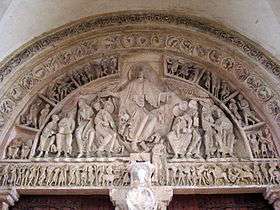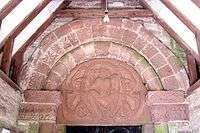Tympanum (architecture)

In architecture, a tympanum (plural, tympana) is the semi-circular or triangular decorative wall surface over an entrance, door or window, bounded by a lintel and arch.[1] It often contains sculpture or other imagery or ornaments.[2] Most architectural styles include this element.[3] In ancient Greek and Roman and in Christian architecture tympana usually contain religious imagery,[4] when on religious buildings. A tympanum over a doorway is very often the most important, or only, location for monumental sculpture on the outside of a building. In classical architecture, and in classicising styles from the Renaissance onwards, major examples are usually triangular; in Romanesque architecture they have a semi-circular shape, or that of a thinner slice from the top of a circle, and in Gothic architecture they have a more vertical shape, coming to a point at the top. These shapes naturally influence the typical compositions of any sculpture within the tympanum.
Bands of molding surrounding the tympanum are referred to as the archivolt.[5] In medieval French architecture the tympanum is often supported by a decorated pillar called a trumeau.
Gallery
 Ex Nihilo (Out of Nothing) by Frederick Hart, tympanum over center doors, Washington National Cathedral.
Ex Nihilo (Out of Nothing) by Frederick Hart, tympanum over center doors, Washington National Cathedral. Tympanum of Kumari-ghar at Basantapur Durbar Square,Kathmandu
Tympanum of Kumari-ghar at Basantapur Durbar Square,Kathmandu The three tympana on the main façade of Notre-Dame de Paris, France
The three tympana on the main façade of Notre-Dame de Paris, France Tympanum of Bhagwati Temple Naksaal, Kathmandu
Tympanum of Bhagwati Temple Naksaal, Kathmandu_(6364409273).jpg) Tympanum of Banteay Srei, Cambodia, depicting Sunda and Upasunda fight over the Apsara Tilottama.
Tympanum of Banteay Srei, Cambodia, depicting Sunda and Upasunda fight over the Apsara Tilottama.- Sculpted tympanum in Stralsund, Germany
 Adoration of the Magi on a tympanum on Saint-Thiébaut Church, Thann, France
Adoration of the Magi on a tympanum on Saint-Thiébaut Church, Thann, France Religious scene in a tympanum, Saint Joseph church, Clermont-Ferrand, France
Religious scene in a tympanum, Saint Joseph church, Clermont-Ferrand, France- Scenes of the lives of Saint Peter and Mary, St Peter's, Vitoria-Gasteiz, Spain
 High-relief bronze tympanum of Writing, Thomas Jefferson Building, Washington, DC, USA
High-relief bronze tympanum of Writing, Thomas Jefferson Building, Washington, DC, USA
 Tympanum showing Christ in Majesty with four attendant angels, Rowlestone, Herefordshire, UK
Tympanum showing Christ in Majesty with four attendant angels, Rowlestone, Herefordshire, UK Typanum of the Manila Cathedral in Intramuros, Philippines
Typanum of the Manila Cathedral in Intramuros, Philippines
See also
Notes
- ↑ "Glossary - Tympanum". Architecture of the Indian Subcontinent. Retrieved 2007-06-28.
- ↑ "Glossary of Medieval Art and Architecture - tympanum". University of Pittsburgh. Retrieved 2007-06-23.
- ↑ "Illustrated Architecture Dictionary - Tympanum". www.buffaloah.com. Retrieved 2014-04-12.
- ↑ "Tympanum". www.OntarioArchitecture.com. Retrieved 2007-06-25.
- ↑ "Glossary of Medieval Art and Architecture - archivolt". University of Pittsburgh. Retrieved 2007-06-23.
External links
| Wikimedia Commons has media related to tympanums. |
| Wikisource has the text of the 1911 Encyclopædia Britannica article Tympanum. |
- Sculpted tympanums Chartres Cathedral, West Front, Central Portal
- Tympanum of the last Judgment - western portal of the abbey-church of Saint Foy